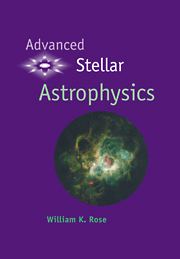Book contents
- Frontmatter
- Contents
- Preface
- 1 Star formation and stellar evolution: an overview
- 2 Introduction to the physics of stellar interiors and the equations of stellar structure
- 3 Statistical physics
- 4 Absorption processes
- 5 Stellar atmospheres, convective envelopes and stellar winds
- 6 Thermonuclear reactions and nucleosynthesis
- 7 Weak interactions in stellar interiors
- 8 Stellar stability and hydrodynamics
- 9 Binary stars, mass accretion, stellar rotation and meridional circulation
- 10 Stellar magnetic fields
- 11 White dwarfs, novae and supernovae
- 12 General relativity
- 13 Neutron stars and black holes
- Appendix 1 Physical and astronomical constants
- Appendix 2 Further comments on the Dirac equation
- Appendix 3 Mathematical appendix
- Appendix 4 Polytropes and the isothermal gas sphere
- Appendix 5 Solutions to selected problems
- References
- Index
11 - White dwarfs, novae and supernovae
Published online by Cambridge University Press: 05 June 2012
- Frontmatter
- Contents
- Preface
- 1 Star formation and stellar evolution: an overview
- 2 Introduction to the physics of stellar interiors and the equations of stellar structure
- 3 Statistical physics
- 4 Absorption processes
- 5 Stellar atmospheres, convective envelopes and stellar winds
- 6 Thermonuclear reactions and nucleosynthesis
- 7 Weak interactions in stellar interiors
- 8 Stellar stability and hydrodynamics
- 9 Binary stars, mass accretion, stellar rotation and meridional circulation
- 10 Stellar magnetic fields
- 11 White dwarfs, novae and supernovae
- 12 General relativity
- 13 Neutron stars and black holes
- Appendix 1 Physical and astronomical constants
- Appendix 2 Further comments on the Dirac equation
- Appendix 3 Mathematical appendix
- Appendix 4 Polytropes and the isothermal gas sphere
- Appendix 5 Solutions to selected problems
- References
- Index
Summary
White dwarfs
White dwarfs have low luminosities (∼ 10-4 - 1L⊙) but their photospheric temperatures (T ≃ 6000 – 2 × 104 K) are comparable to those of main-sequence stars. It follows that the radii of white dwarfs are small (≃ 109 cm). The masses and radii of several white dwarfs in binary systems have been determined. The white dwarfs Sirius B and 40 Eri B are known to have masses and radii equal to (M = 1.05 M⊙, R = 0.0074 R⊙) and (M = 0.48 M⊙, R = 0.0124 R⊙) respectively. Because the central densities of white dwarfs are high (≃ 106-109 g cm-3) and the temperatures of their isothermal cores relatively low (∼ 107 K), electrons are completely degenerate except in thin surface layers.
The structures of white dwarfs are determined by the equations of hydrostatic equilibrium (Equation (2.27)), mass conservation (Equation (2.28)) and the equation of state of an electron-degenerate gas described in Section 3.2. Unlike main-sequence stars the radii of white dwarfs decrease as a function of increasing mass and in addition there exists an upper limit to the mass of a white dwarf. This mass limit, which is known as the Chandrasekhar mass limit, depends on the electron molecular weight because the electron pressure increases as the number density of electrons increases. The calculated white dwarf mass limit Mc for uniform electron molecular weight μe is
Since most white dwarfs consist primarily of fully ionized 4He, 12C and 16O their electron molecular weight is μe = 2.
- Type
- Chapter
- Information
- Advanced Stellar Astrophysics , pp. 325 - 358Publisher: Cambridge University PressPrint publication year: 1998



